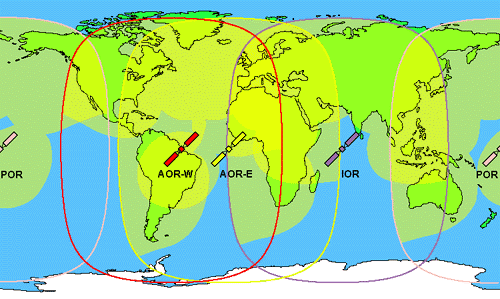Inmarsat's previous generation I3 satellites (Mini-M, Fleet 33/55/77 systems) used 4 satellites to cover what Inmarsat refer to as "global coverage". Clearly with geostationary satellites you cannot get coverage at the poles, but for most practical purposes the coverage is in fact nearly global
The advantage of the geostationary satellites is that your satellite antenna does not need a clear view of the whole sky, but only a narrow gap pointing directly at the satellite (possible between two buildings or a gap in the tree canopy). However, because the satellites are in fixed orbit there are some gaps in global coverage (see coverage map below)
Inmarsat have a large portfolio of products, generally aimed at the fixed installation, marine and aviation market, but covering a range of price and performance categories
Coverage For I3 Satellites (Fleet 33/55/77)
Coverage is near global for voice, but data is stated as "spot". This generally means good data access near large land masses, but there are significant black spots covering significant amounts of ocean where it's simply not possible to get "data" (ie computer) access on the smaller F33 system (but you can still get slower dialup speeds, and voice coverage is "global")
Most Inmarsat systems are suitable for ocean passages though, but it's important to be aware of the coverage areas.
Broadly speaking for the ocean cruiser the areas to watch out are crossing the Pacific just after Panama, and the southern Atlantic on route from Cape Town to South America.
Capabilities of different sized Fleet Systems
The Fleet systems vary in performance depending on the size of dish.
| F33 | F55 | F77 | |
|---|---|---|---|
| Coverage | |||
| Spot Beam Coverage | X | X | |
| Global Coverage | X | ||
| Communication | |||
| Mini-M Voice (4.8Kbs) | X | X | X |
| Speech (64Kbs voice) | X | X | |
| 3.1Khz Audio | X | X | |
| 128Kbs Data | X | ||
| MPDS (up to 64Kbs) | X1 | X | X |
| 9.6Kbs Data | X | ||
| 9.6Kbs Fax | X | X | X |
| Safety | |||
| Global Voice Distress | X | ||
1MPDS on F33 = 64Kbs down, 28Kbs up
Running Costs
Call costs start at around $1.50/min. However, there is no "monthly line rental", which makes the cost per minute a little cheaper than Iridium in practice
Data services vary depending on the speed required. However, Inmarsat are one of only a few products which can offer the option of very high speed "broadband" style internet access. However, prices for this are a good deal higher than a fixed install broadband satellite system at home!
Internet access is quite reasonable with the Fleet system and you can elect to use a billing plan where you are charged by the amount of data you transfer, rather than the time you spend online. This is very similar to using "GPRS" on your mobile phone (except that your mobile phone doesn't work in the middle of an ocean)
Approximate prices are as follows:
| Voice Peak | Voice O/Peak | Fax Peak | Fax O/Peak | Telex | 9.6 Kbps Data | 64 Kbps Data | MPDS (per megabit) | |
| Inmarsat A | $3.75 | $2.75 | $3.75 | $2.75 | $3.25 | $3.75 | $10.50 | N/A |
| Inmarsat B | $1.75 | $1.50 | $1.75 | $1.75 | $3.25 | $1.75 | $6.25 | N/A |
| Inmarsat Fleet | $1.55 | $1.35 | ** | ** | N/A | $2.30 | $5.95 | $2.95 |
| Inmarsat Mini M | $1.50 | $1.50 | $1.50 | $1.50 | N/A | N/A | N/A | N/A |
| Inmarsat C | N/A | N/A | $0.80 ($0.12 per 1024 bits) | $0.80 ($0.12 per 1024 bits) | $0.80 ($0.12 per 1024 bits) | N/A | N/A | N/A |
Equipment
All the equipment is really for "fixed install" (ie "screwed to a wall"), although the mini-M units are available in a briefcased size "portable" unit. In general, for portable applications consider one of the other networks.
- Mini-M
- Fleet 33
- Fleet 55
- Fleet 77





